Your child was up all night sick. An unplanned meeting pops up during 5th period. Or your car breaks down on the way to school. Yikes. Sometimes unexpected circumstances arise, and you won’t have time to create last minute art sub plans. That’s why you need an emergency art teacher sub binder!
My binder holds 1-day art worksheets that my substitute teacher can quickly print and pass out. Not to mention it contains important information to keep the art room functioning until you return. If you’ve never created a substitute binder before, here’s everything you need to know to put one together yourself.
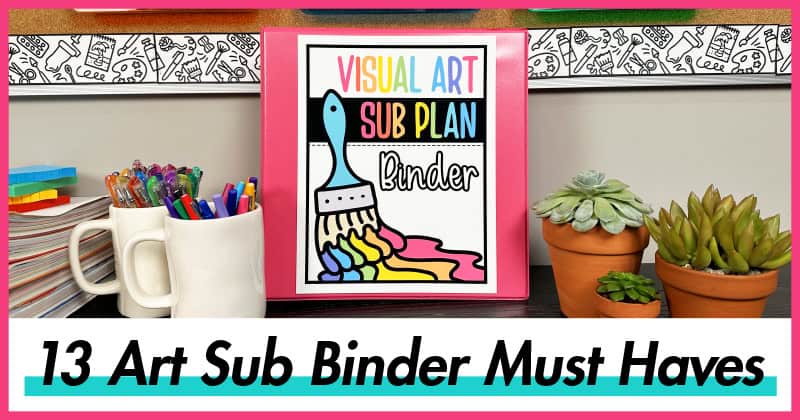
What Materials Do I Need to Put My Art Sub Binder Together?
Most of these materials you may have laying around:
- 3-Ring Binder
- Sheet Protectors
- Cardstock Paper
- Copy Paper
- Binder Tabs (optional)
- 3-Ring Hole Punch (optional)
What Should An Art Sub Binder Have?
Most schools require art teachers to have an emergency sub binder in a visible place in their classroom. Mine is located by the door and telephone so I can grab it as I’m heading out for a fire drill. Having a clearly-labeled cover design will help your substitute locate it quickly.
Beyond that, here’s what I keep inside mine:
- Welcome letter for your guest teacher
- Teaching schedule and duties
- Seating charts
- Art room layout map
- Rules, procedures, rewards, and consequences
- Substitute expectations
- Emergency management info
- Class rosters
- Student allergies and health concerns
- Map of the school egress route
- Technology info
- Emergency art sub plans
- Substitute report form
Let’s look at some of these components up close.
1) Write a Welcome Letter
You’ve managed to get someone to cover your art lessons, hurrah! A nice gesture is to write a simple note to say “thanks” for their time and effort.
However, I can’t stress this enough: keep it short and to the point. They won’t have time to read your entire epic biography.

I like my letter to include:
- An overview of what’s inside
- A request they fill out the sub form after each class
- A note specifying what to do if I haven’t left specific lessons for each class
- A way to contact me in case of emergencies
2) Schedules & Duties
The first thing your art teacher substitute will need to know is when kids will be coming and for how long. You’ll want to include either weekly or daily class schedules that list the name of class either by teacher name or class abbreviation (i.e. “3B”).
Likely your school has shortened schedules for late arrival and early dismissal. Be sure to add those in, too!
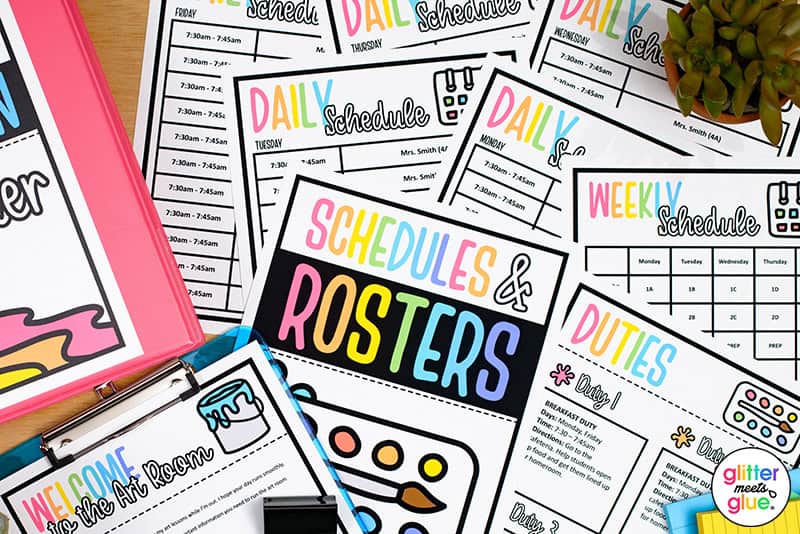
And lastly, be sure to include a detailed list of your duties. They’ll need to know the name of the duty, the days and times it needs to be fulfilled, and any specific directions as to what they need to do during the duty.
3) Seating Charts
If you’re an art teacher who uses seating charts, add those in your sub binder for every class on your roster. Seating charts are a great way to take quick visual attendance. And, to practice student names. Both of which your guest teacher will need!
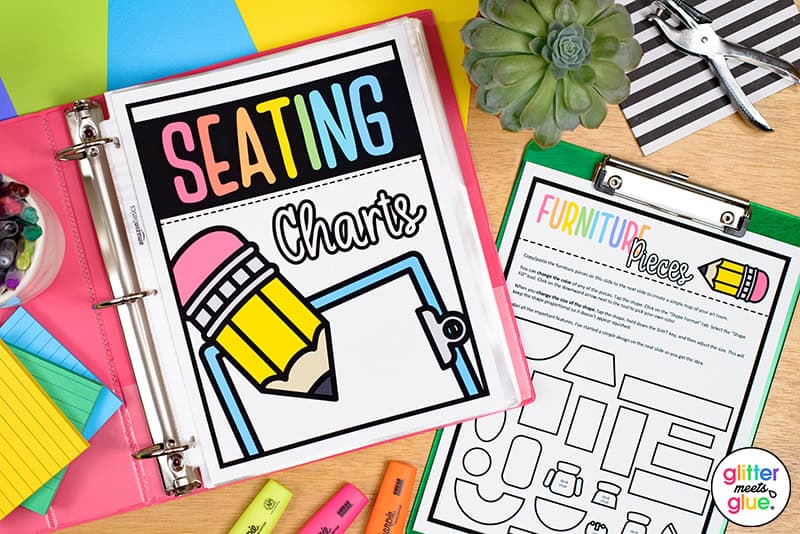
You can use either PowerPoint or Google Slides to design basic table shapes. And then label them with student names according to where they sit. Just be sure to pit something on the chart as a reference so your guest teacher knows which way the chart faces. So add in a doorway, a window, or the front board.
4) Art Room Layout Map
Do you label your tables with colors or silly names? Would your substitute art teacher know where to find certain materials? Can they easily find what they need? Including a map of your art room will alleviate all of that!

Draw out a simple layout of your art room and label all the important features. This will help your sub get up to speed quickly as to where things are located. You can either draw it out by hand, in PowerPoint, or just snap pictures of the room and edit the photos with text overlays.
5) Rules, Procedures, Rewards, & Consequences
To run your art room in your place, your guest teacher will need to know your classroom management plan including any art room jobs. That includes any rules, expectations, procedures, rewards, and consequences you have set in place.
This includes any unwritten expectations. I require 3rd grade and up to bring their own art folder and a pencil, for example. And while being prepared isn’t a written rule in my class, it’s certainly an expectation that needs mentioning.
Think on how you want your substitute to handle issues when they arise. Smaller infractions can be dealt with on the spot.
But would you prefer they write you a note for larger issues so you can handle it when you return? Or would you prefer they call the front office? And, what kinds of issues are mandatory for them to call the front office about? Outlining all of this will help your sub teacher greatly.
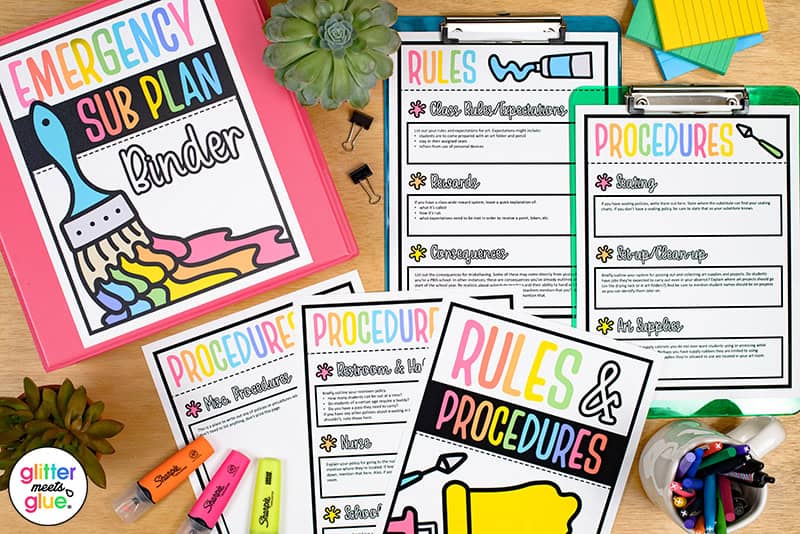
Do you have a rewards program like brag bracelets or bookmarks that you hand out at the end of class? How does it work?
To set your guest teacher up for success, make sure to clue them in on how to get kids to be on their best behavior. Your substitute art teacher will appreciate it!
The procedures section of my binder is divided into the following sub-sections:
- Seating
- Set-up & Clean-up
- Art Supplies
- Restroom & Hallway
- Nurse
- School Counselor
- Misc.
Your school might have important school-wide, non-emergency procedures they want teachers to be aware of that should be added in here, too.
6) Substitute Expectations
I’m also a fan of leaving a short list of general expectations directed at the substitute teacher. Because kids will take advantage if you don’t. My list sounds something like this:
- Discourage restroom and water fountain breaks as much as possible. Their teacher takes them before class every week.
- Students must sit in their assigned seats.
- Everyone is to clean up after themselves, including their floor area.
- Monitor kids at the sink area.
This helps set the tone and keeps expectations consistent while you’re absent.
7) Emergency Management Information
Speaking of emergencies, your art teacher sub binder absolutely needs to include a detailed list of how school-wide emergencies are handled. Be advised these sometimes change slightly from year to year. That can be something as simple as your egress location for drills to how certain drills are handled.
Having been through a couple real-life emergencies myself – a gas leak and a sewer pipe leak – you need to prep your substitute for them! Even if the real thing doesn’t ever happen.
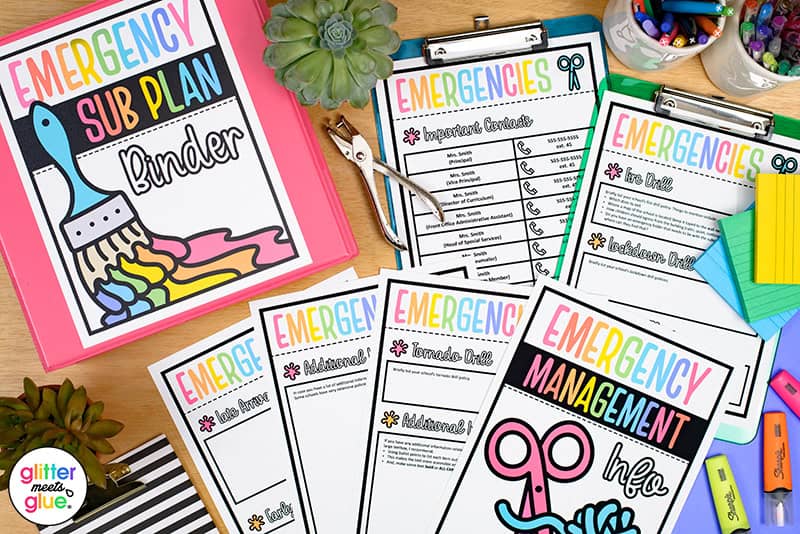
Some procedures to address include drills for:
- Fires
- Lockdowns
- Shelter in place
- Late Arrival/Early Dismissal (during any school-wide drill)
- Tornadoes
- Earthquakes
Also include a master list of important contacts in the school. Those should include phone extensions for the principal, vice-principal, head of special services, school counselor, nurse, and every teacher in the building whose students you teach weekly.
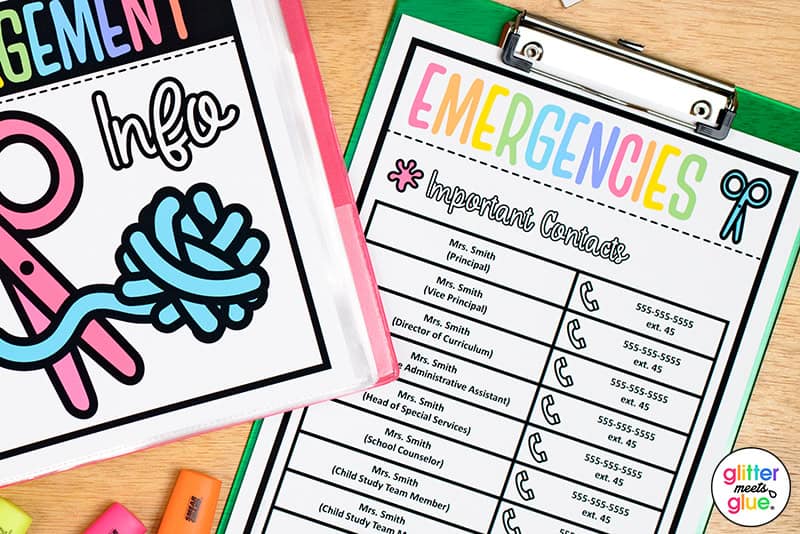
8) Class Rosters
This may be specific to the last school I worked at, but we were required to include the class rosters given to us not the first day of school. This was for emergency reasons in case we needed to rush out of the building for an evacuation drill and needed to take rolling attendance at various intervals on the walk to the evacuation site.
If your school does the same, just punch holes in the handouts and add them in.
9) Student Allergies and Health Concerns
Your school may provide you with a list of these students at the start of the year. Make an extra copy, punch holes in the pages, and add them into the emergency management section.
One extra tip. It may be helpful to color coordinate some of the health concerns to the students you teach (because the list they may give out may include students you don’t teach but are in the building). So, locate the class rosters and highlight any kids on them that also have health concerns to be aware of. This is both helpful for you and your sub!
If your school passes out teaching handouts for things like asthma, add those in, too.
10) Map of the School Egress Route
My school handed out a couple copies of the egress route for all drills. It was a map of the school with every room labeled and colored arrows pointing from, in my case, the art room to the nearest door. If you don’t get two copies, make one. Then post one on the inside of your door (or very near the door) at eye level. And leave the other in the binder.
11) Art Room Technology Information
These days, most art rooms are outfitted with basic tech devices: desktop or laptop computer, smartboard, and projector. But with those devices come some quirks. Like how to turn them on. Or, if one of them acts a little finicky.
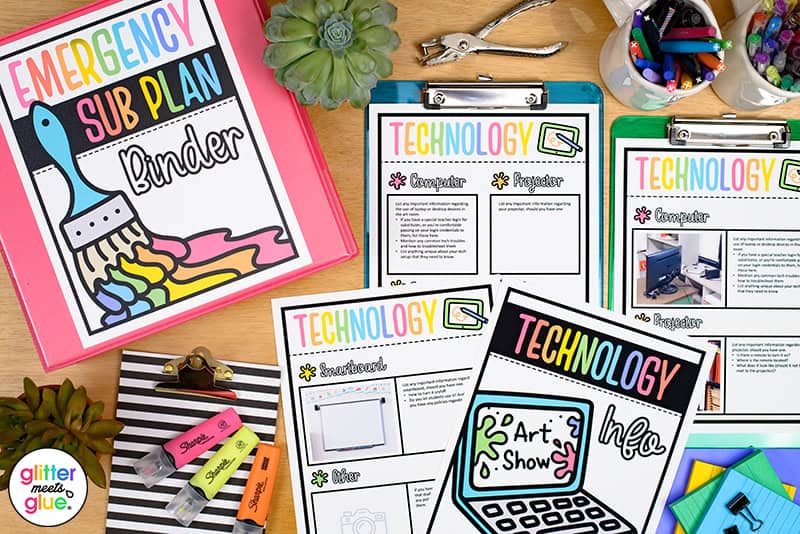
Adding in a section to your sub binder about all the ins and outs of your tech devices will help things run smoothly.
12) Emergency Art Sub Plans
When it comes to emergency art sub plans, the key is to keep it simple. A guest teacher coming in last minute doesn’t have time to read over detailed lesson plans with multiple step by step directions that requires a lot of thinking. Save those for days when you know you’ll be out in advance (especially more than one day in a row).
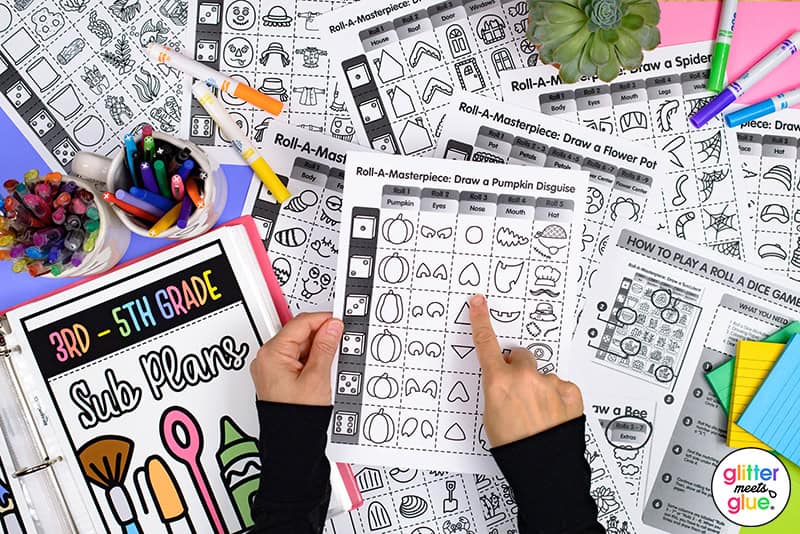
Simple art worksheets that can be used for a single class period for the win! You’ll need at least 3 weeks of worksheets organized by grade level or bracketed grade levels (K – 2, 3 – 5, and 6 – 8). Expect to refresh the plans should you be absent more than a few times.
Some examples of activities that work include:
- Grid drawings
- Symmetry drawings
- Roll a dice games
- Design Your Own worksheets
- 1-Page paper crafts
- Directed drawings
Your sub may not have time to run to a copy machine. So make copies of each worksheet and put them in labeled folders. Inside your art teacher sub binder, leave copies labeled “teacher copy” and directions on where to locate all the student copies you made.
13) Substitute Report Form
When you come back from being out, the first thing you’ll want to know is how things went. And if there are any issues you need to address with students or faculty immediately.
Your sub report form should have a section asking the guest teacher to rate how the class behaved. And, to make a list of any absent, late, helpful, or disruptive students.
Creating an Art Sub Tub
Additionally you might decide to gather everything into one large plastic container, called a “sub tub.” Here’s what to include:
- Art sub binder (as described above)
- Basic art supplies like crayons, markers, colored pencils, and paper to be used with your emergency art lessons. No need for your substitute teacher to rummage through your things!
- Sign indicating it’s an art sub tub
If your school wants an emergency sub folder filed away in the main office, snap a picture of the sub tub in your room. Then, include it in the folder so a supply teacher knows where to find it.
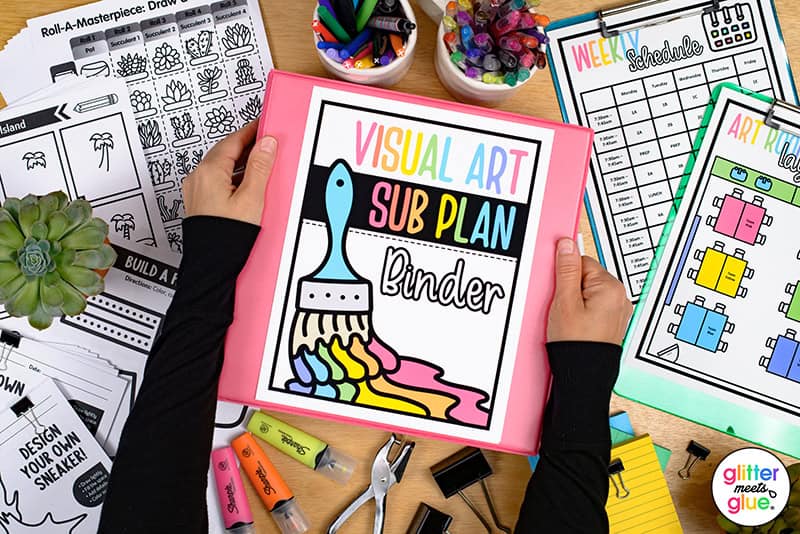
Conclusion: Creating an Art Teacher Sub Binder is A Lot of Work!
Does reading all of this make you feel overwhelmed? I’ll bet. It’s a lot.
But luckily I’ve saved you a boatload of time by creating all the forms and art worksheets you’ll need! All you need to do is add in your own personal information and print out the activities.
Grab the entire art teacher sub binder with everything included. And don’t sweat this. I got you covered!



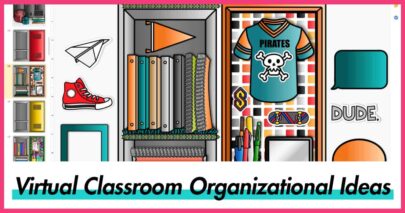
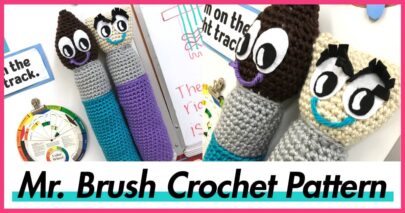

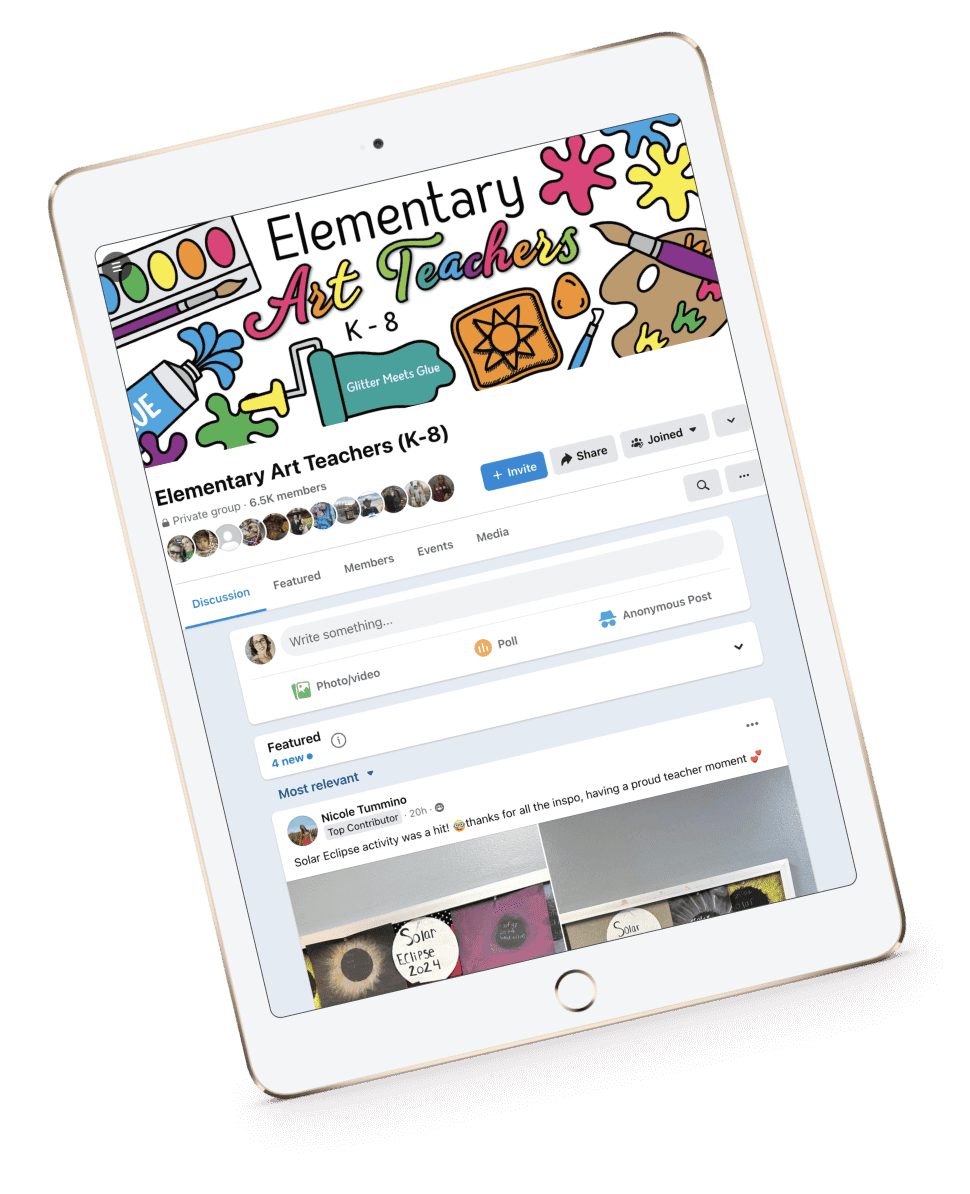

Leave a Comment